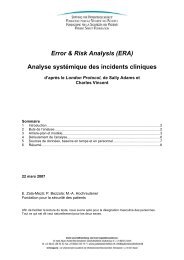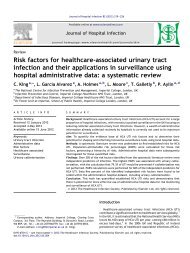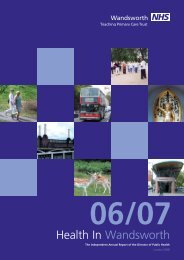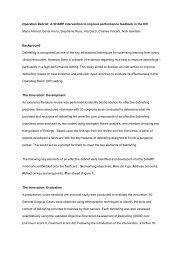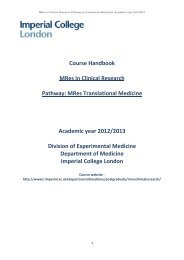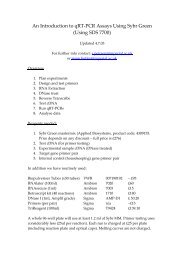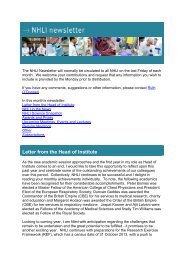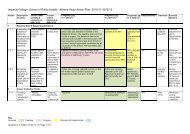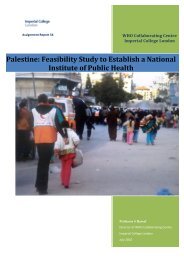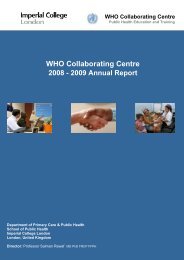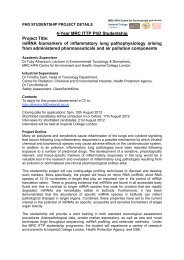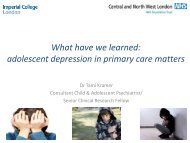QOF Plus Year 1 - Imperial College London
QOF Plus Year 1 - Imperial College London
QOF Plus Year 1 - Imperial College London
You also want an ePaper? Increase the reach of your titles
YUMPU automatically turns print PDFs into web optimized ePapers that Google loves.
achieved through primary prevention strategies to reduce blood pressure and cholesterol levels,such as lifestyle change and use of pharmaceutical agents including statins, and there is goodevidence of the cost-effectiveness of statins in primary prevention (Cooper et al., 2008).The NICE Guideline on Lipid Modification (Cooper et al., 2008) issues the followingrecommendations:For the primary prevention of CVD in primary care, a systematic strategy should be usedto identify people aged between 40 and 74 who are likely to be at high risk.People should be prioritised on the basis of an estimate of their CVD risk before a fullformal risk assessment.Their CVD risk should be estimated using CVD risk factors already recorded in primarycare electronic medical records.People older than 40 should have their estimate of CVD risk reviewed on an ongoingbasis.People should be prioritised for a full formal risk assessment if their estimated 10-yearrisk of CVD is 20% or more.Healthcare professionals should discuss the process of risk assessment with the personidentified as being at risk, including the option of declining any formal risk assessment.Opportunistic assessment should not be the main strategy used in primary care toidentify CVD risk in unselected people.Many of the current CVD risk assessment tools are based on data from the Framingham study,and other tools are currently in development. The Framingham data uses factors including age,gender, smoking status, diabetic status, blood pressure and cholesterol levels, and presence ofleft ventricular hypertrophy to estimate risk. The Framingham equations were derived from workon a mainly white, middle-class American cohort, and may therefore not be accurate in UKpopulations, including people from ethnic minorities. The Framingham equations have also beenshown to underestimate risk in people with a family history of coronary heart disease, and inlower socio-economic groups. Other risk equations are also being developed and these includeASSIGN (developed using a Scottish cohort) and QRISK (developed with data from UK generalpractice databases). These have the advantage of taking into account factors such as familyhistory and social deprivation. The NICE Guideline on Lipid Modification (Cooper et al., 2008)recommend the continued use of the Framingham equations at present to calculate risk, buthighlight “an urgent need to establish which score is most acceptable for use in the population ofEngland and Wales.”Evidence from economic modelling in an English primary care population shows that prioritisingpatients based upon a prior estimate of their CVD risk using data already held in generalpractitioners’ electronic medical records is the most efficient strategy for identifying people athigh risk of developing CVD.The current JBS 2 guidelines recommend that risk assessment should include ethnicity, smokinghabit history, family history of CVD, and measurements of weight, waist circumference, bloodpressure, non-fasting lipids (total cholesterol and HDL-cholesterol) and non-fasting glucose (JointBritish Societies, 2005). These recommendations are reflected in the SIGN guidelines whichsuggest gathering of additional information on age, gender, socio-economic status and renalfunction (SIGN, 2007).23



